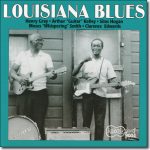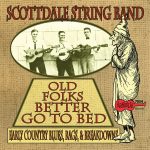Smoky Babe – Way Back in the Country Blues / Arhoolie CD-548
$14.98
In stock
Description
CD 548
1. Boss Man Blues
2. Backyard Boogie
3. Bad Luck and Trouble
4. Diggin’ My Potatoes
5. What’s Wrong With You
6. Chicago Bound
7. If I Had Listened to What My Mama Say
8. On Mr. Walter’s Farm
9. I’m Going Home on the Morning Train
10. I’m Goin’ Away Baby*
11. Way Back in the Country Blues
12. Shake Shake Mattie
13. I’m Wild About You Black Gal*
14. Arkansas Blues*
15. Terraplane Blues*
16. Goin’ Home Blues
17. Boogie Gal
*only on CD not on LP
“…another glimpse of one of the most intriguing bluesmen that ever lived. If he were recognized on merit Babe would have made the list with his more famous contemporaries. His guitar playing is dead on and rhythmically rooted with occasional blitzing finger-picking runs on the high strings in between his heavy down strokes. Like a good solo performer Babe’s textures vary sometimes with driving one-chord boogies and sometimes by digging into the lower strings for a darker contrast. While it’s hard to fault anything about his style as evidenced by this high-grade field recording his confident baritone vocals are more prominent… Whether it’s escaping to Chicago digging up potatoes or whining about women Babe was one of those rare bluesmen who was raw but refined in his approach while delivering entertaining blues fodder. A great discovery.”
-Dan Willging Offbeat
“‘His guitar was in pawn so I loaned him mine. As soon as he had played a few bars rich full resonant and excitingly rhythmic I knew that here was an outstanding blues man.’ Thus Harry Oster on his first meeting Robert ‘Smoky Babe’ Brown…Those of us who’ve long treasured Smoky Babe’s issued recordings had the same reaction the first time the stylus hit the grooves and have always regretted that there weren’t more tracks available. Now there are and Way Back in the Country Blues seems likely to be my release of the year…We already knew that Smoky Babe was a major musician but it’s a delight to have his status so comprehensively confirmed.”
-Chris Smith Blues & Rhythm
From the album notes by Adam Machado:
Today it is hard to find anyone at all who remembers Robert Brown the powerful Mississippi-born guitar player and singer known to a few blues fans as Smoky Babe. In fact so far we have found only one: harmonica man Lazy Lester. “He was just a little street guitar player” Lester recalls. “Hung around the drinking tree on Bradley Road where everybody would come drink wine play guitar play harmonica sing and just have fun. That’s how I knew him.”
In February 1960 Lester was renting a room in the Scotlandville Louisiana home of Miss Sally Jenkins a popular hangout for musicians when folklorist Harry Oster of L.S.U. stopped by with a tape recorder and that little street guitar player Lester recognized from under the drinking tree. Smoky Babe was not then nor would he ever be well known on the Baton Rouge music scene. Unlike Lester Lightnin’ Slim Silas Hogan Slim Harpo and others Smoky was not among the local artists whose Excello records were at that moment defining Louisiana blues. But Dr. Oster was looking to document outstanding unrecorded rural musicians and Smoky more than fit that bill.
What little we know of Smoky’s life comes mostly from the brief biographical sketch on the back of his first two LPs: Hot Blues (Folk-Lyric 118) and Hottest Brand Goin’ (Bluesville 1063) both of which include songs cut that day at Sally’s. Oster writes: Smoky Babe (Robert Brown) was born in 1927 in Itta Bena Mississippi a farming area some fifty miles from Clarksdale… His background consists of… a few months of school early years as a sharecropper on a plantation raising cotton corn and garden vegetables frequent moves to other plantations when the crops petered out or he “didn’t get paid right” a spell in city slums while working on a “hot truck” (a carrier of hot steel) in the mill at Bessemer Alabama a period as loader at the French Market in New Orleans while at the same time in the evenings he worked gigs in colored night clubs where he played for dimes quarters and half-dollars dancers tossed to the stage dismal months working on the Mississippi near Baton Rouge cleaning barges and later a post as grease monkey and mechanic at a filling station in Scotlandville Louisiana. And Scotlandville is where he was living in 1960 when he showed up for a party at Mabel Lee Williams’ house and met the professor with the tape recorder. Oster continues:
Smoky who lives a short distance from Mabel Lee Williams swaggered in — a muscular wiry man of about 5’8” wearing a hat tilted at a rakish angle. His guitar was in pawn so I loaned him mine. As soon as he had played a few bars rich full resonant and excitingly rhythmic I knew that here was an outstanding blues man.
Oster’s introduction to the Baton Rouge black community came through Mabel Lee’s brother Robert Pete Williams the distinctive guitarist and singer he had recorded over many months the previous year at Angola State Penitentiary. When they met in January 1959 Williams was three years into a life sentence for murder. By December he was out on parole possibly through the lobbying efforts of Oster and others. After a full pardon in 1964 he would become active on the blues revival circuit playing at festivals folk clubs and college campuses around the country while making further records for Harry and others. But in 1960 Williams was working on a farm in the nearby town of Denham Springs when he took Harry to meet his friends in Scotlandville. The connection was paramount for Oster leading not only to Smoky but also to several others most notably the astonishing fiddler Butch Cage and his longtime partner Willie B. Thomas.
Scotlandville or Scotland as it’s known locally is a predominantly black neighborhood that sits along Scenic Highway in the shadow of the oil refineries of East Baton Rouge. “It was basically a country in the city community” former Louisiana State Folklorist Nick Spitzer explains. “They were definitely agrarians who had come to town and it was a place of BBQ and church suppers and blues honky tonks and some were a little rough.” Guitarist Harvey Knox remembers the scene: “Everywhere you looked they had bars. Wishadell’s Dream Club used to have bands. Anderson’s bar used to have bands. In The Hole used to have bands. That was a little bitty place but it used to have bands. Tropicana had bands. That was a big old place right around the corner from Miss Sally Jenkins. They had a liquor store downstairs and a nice nightclub upstairs.” Bradley’s Grocery Field’s Grocery Whitfield’s the Dew Drop the Green Parrot and the Black Cat were a handful of other clubs happening at the time. Asked which of all these spots a street guy like Smoky might have played Harvey says probably a small place like In The Hole. “That was kind of geared up for real small groups like two or three pieces.” Yet it is unknown whether Smoky ever played out around Baton Rouge for money on his own or otherwise. Lester remembers seeing him at the bars now and then but only as a customer. “I’m going to be honest at the time when Slim Harpo and Silas Hogan and I were out doing those gigs he wasn’t ever there unless we played on Bradley Road at Field’s Grocery or something like that. That’s just about the onliest club that he would come to. When we was in walking distance from him he would show up.”
In August 1961 Oster drove Smoky north to visit his mother in Vance Mississippi fifty miles past Itta Bena off Highway 49. Annie Brown Smoky promised played a better guitar than her son. The record man was more than interested. Twice along the way his ’55 DeSoto broke down and twice Smoky used his mechanic’s skills to get the car rolling again. Finally they arrived at Annie’s vine-covered country shack as Harry wrote in his 1969 book Living Country Blues a “rickety unpainted little building with sheets from Sunday rotogravure newspaper magazines stuck on the walls for decoration and for protection against the elements.” Over the next two days in the company of family and friends they made what would be their final recordings together. Annie suffering from arthritis could no longer play guitar. But she did sing a few children’s songs and reveal a little more about her youngest son. Robert she tells Harry bought his first guitar at age ten with money he earned selling garden seeds. “Wasn’t nothing but a little old thing and that boy kept on whammin’ on it ’til he found some music in it I reckon.” At ten he was playing for white suppers. By eleven they were coming to get him to play dances. “I was singing behind somebody’s record was already out about “Shoo Shoo Boogie” Smoky explains. “That’s been a long time ago” says Annie. Between February 1960 and August ’61 Oster recorded Smoky Babe on some twenty occasions releasing thirty total songs on three LPs. Most of what he captured on tape went unissued.
In 1963 Harry left Louisiana to teach folklore at the University of Iowa. It is unknown what contact if any he had with Smoky after that. We do know that unlike Robert Pete Williams and many other rural performers at that time Smoky never made it to the blues revival stage. Oster who brought Butch Cage and Willie Thomas to the 1960 Newport Folk Festival would have represented his best shot at meeting that new audience. Presuming of course that is what Smoky would have wanted. In 1970 having turned his attention increasingly toward teaching and away from making records Harry Oster sold his Folk-Lyric label to Chris Strachwitz owner and founder of Arhoolie Records. Over the next three decades Strachwitz reissued many of the original Folk-Lyric titles and added to the catalog in some cases with Oster’s assistance. In Arhoolie’s Smoky Babe file one letter exists dated September 16 1972 and posted to the artist’s last known address. No reply ever came. It is believed that he died in Scotlandville the following year.
Upon Harry’s death in 2001 his widow Caroline shipped what was understood to be the balance of his tapes. Nowhere in the pile were the unissued Smoky Babe recordings. Recently in the early stages of preparing a box set of Harry’s work we noticed that many other known recordings of his were missing from our collection and reached out again to Caroline to see if any had been overlooked. The following week a shipment of boxes arrived filled with tapes dating back to Harry’s Louisiana days. Among this last batch were several reels of Smoky Babe containing many unissued recordings as strong as anything previously available. This record represents what we feel is the best of those long lost performances.
REVIEWS
“We’re used to country blues artists who made a few rare 78s back in the late 1920s being biographical mysteries and thus cult figures but we don’t expect it of those who were recorded in 1960 at the age of 33. But in that very fact probably lie the seeds of the mystery of Smoky Babe. At that point in time blueshounds were mainly interested in old performers those who’d made records in teh late 1920s rather than being born in 1927.
We know that Smoky Babe was born Robert Brown in Itta Bena Mississippi and lived in Alabama before settling in Louisiana where he was recorded by Dr. Harry Oster. Oster released a trio of albums on his tiny independent Folk-Lyric label but they went relatively unnoticed. At that time the folk blues world was getting very excited about the rediscovery of older artists like Son House Skip James Mississippi John Hurt Bukka White and Sleepy John Estes and these would be the performers invited up north for gigs in New York Cambridge and the Newport Folk Festival. Very few ‘new’ names – Fred McDowell was an exception – got a look in.
Oster eventually sold his label to Arhoolie but it was only after his death that the unissued tapes which make up this new album came to light. And what absolute gems they are. You can hear echoes of the guitar styles of John Lee Hooker Bukka White Big Joe Williams the school of Fred McDowell (who it must be remembered was virtually unknown at the time of these recordings) and really strongly the ferocious Mississippi (later Chicago) bluesman Tommy McClennan. He’s got that fabulous driving pulse of McClennan (and McDowell) and the energy and clarity of a young man – he was after all much the same age as those ’20s/’30s legends were when they made their seminal recordings.
But how did he pick up those influences and mold them to his own personal style? Was it from live contact with other artists or listening to records? Even Robert Johnson was clearly doing that back in the ’30s. There doesn’t seem to be much record of him playing live at all but how does a singer/guitarist of such energy get – or need – such a large and well-formed repertoire if he was just a casual player? He sounds like somebody who has done a lot of playing. But these records were made over 50 years ago now and he was last heard of in 1972: he’d be 87 if still alive. So unless this album excites a new generation of blues Sherlocks into investigating the mysteries of artists from long ago – as happened with artists from a mere 35 years ago in the mid-’60s – we may never know.
And that would be a real shame because on the strength of this album Smoky Babe was a major find and you’ll be lucky to hear a better ‘new’ country blues album this year.”
-Ian Anderson fRoots magazine
Additional information
| Weight | 0.31 lbs |
|---|
You must be logged in to post a review.
Related products
-

Louisiana Blues – Various Artists / Arhoolie CD-9004
$10.00 Add to cart -

Scottdale String Band – Old Folks Better Go to Bed / Arhoolie CD-7054
$14.98 Add to cart -

Greek-Oriental Rebetica Songs & Dances – Various Artists CD 7005
$14.98 Add to cart -

Roane County Ramblers: Complete Recordings 1928-1929 / County CD-3530
$11.98 Read more


Reviews
There are no reviews yet.